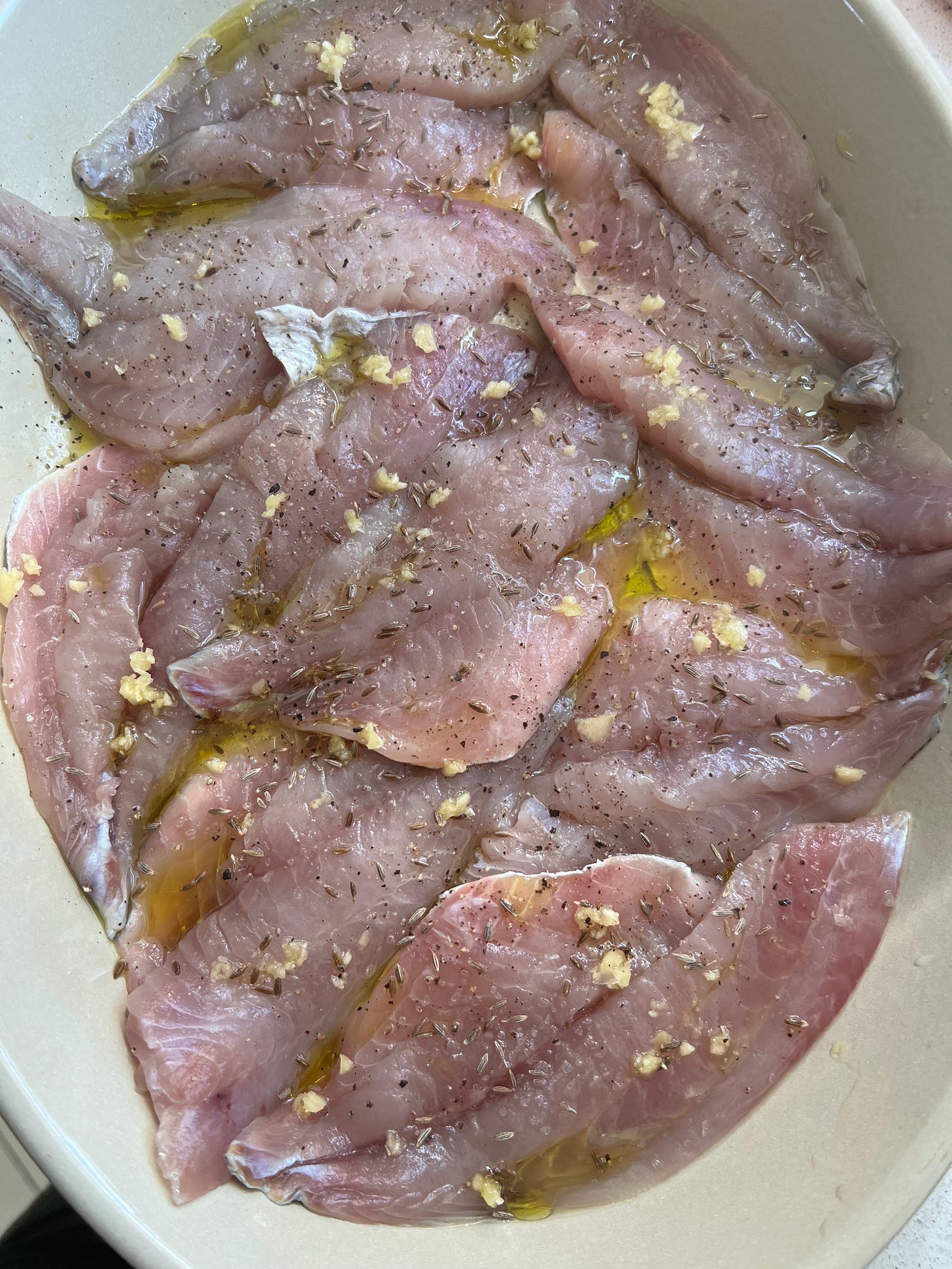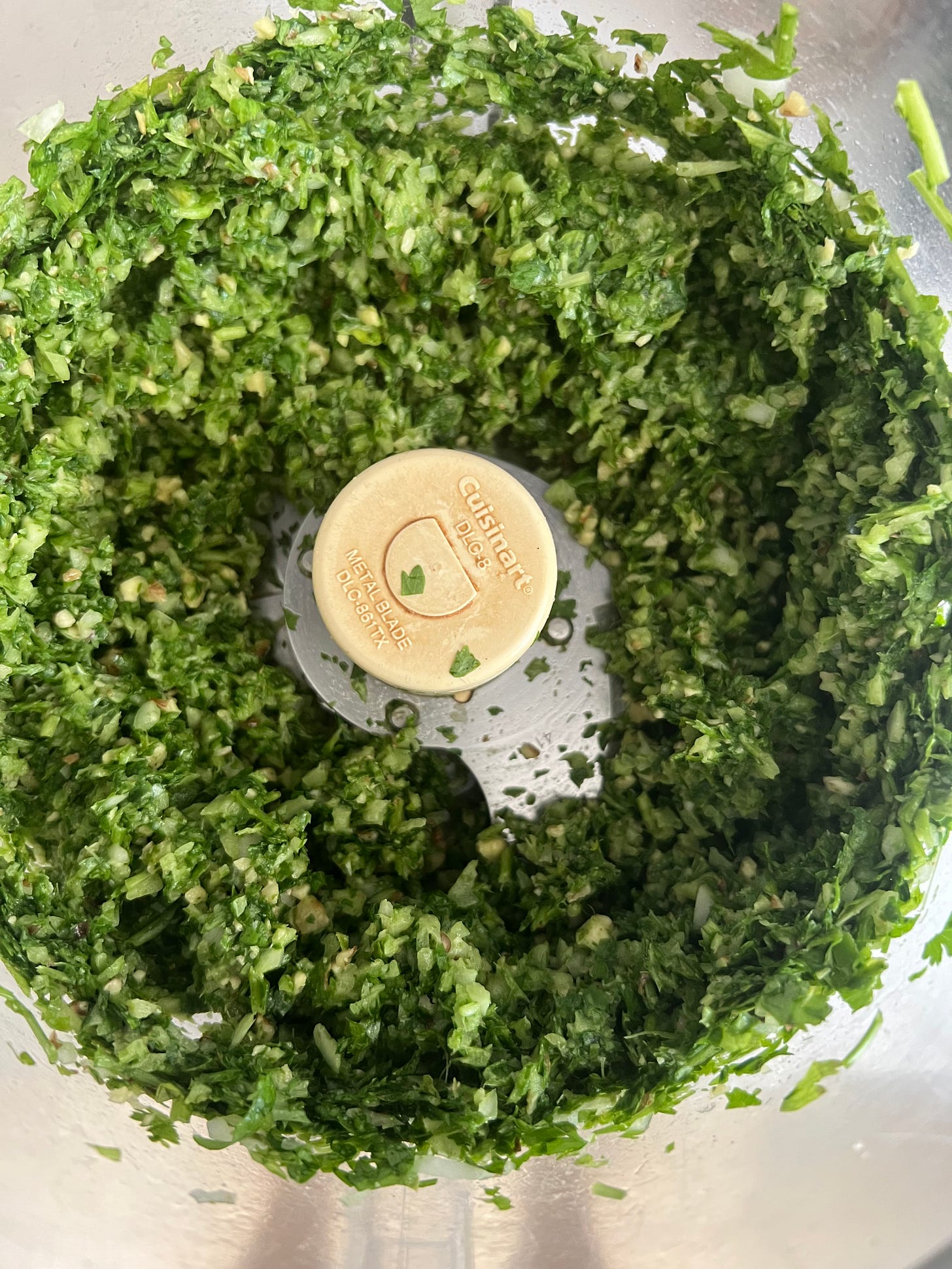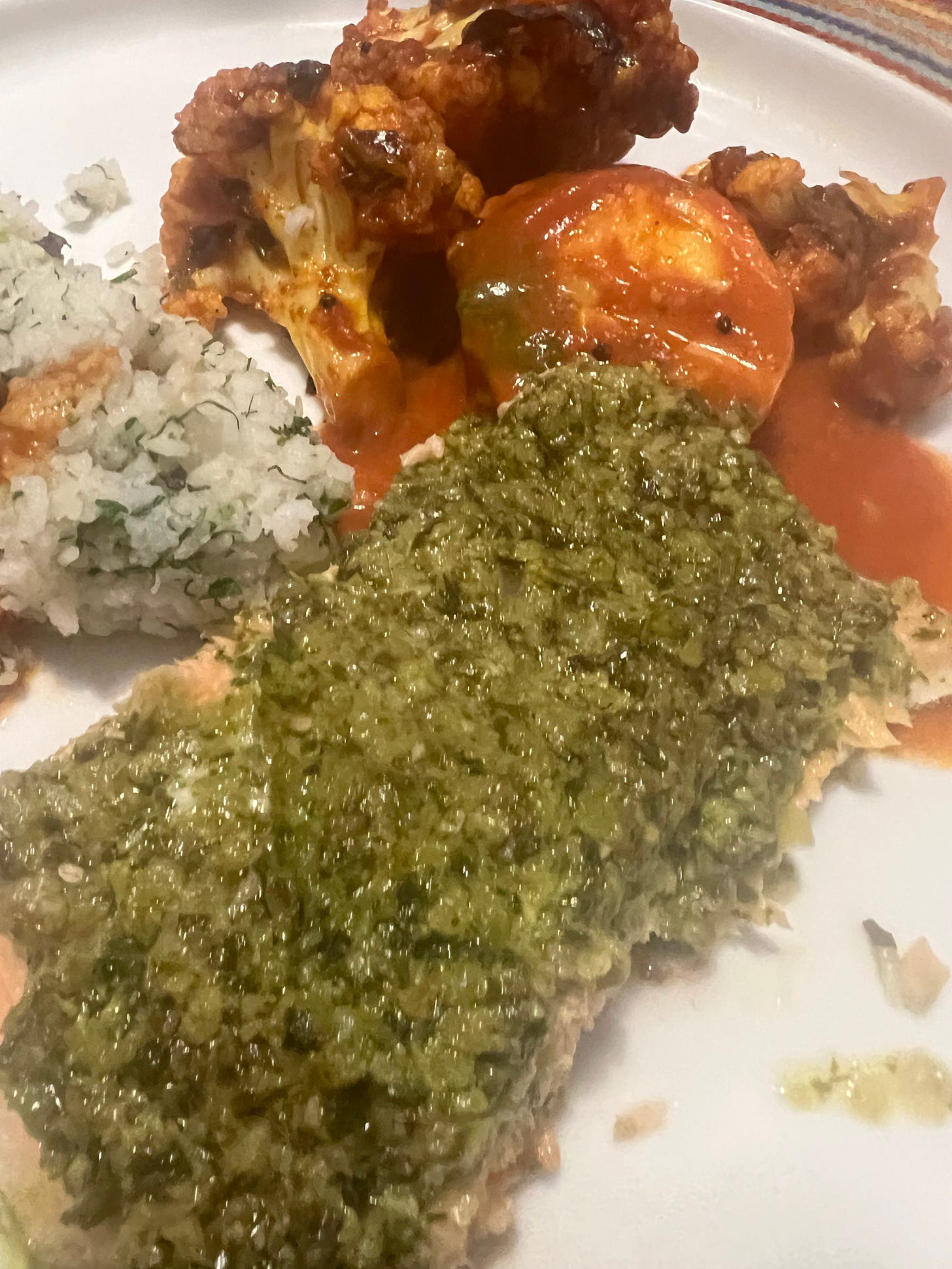Issue #113: Lebanese Spicy Fish
Capitalist Wisdom from Anarchist Deli-Man Ari Weinzweig, Sara's Samke Harra
Hi there! Happy August. The current episode of my What’s Burning podcast features an interview with Ari Weinzweig, the inspiring co-founder of the Ann Arbor, Michigan, culinary destination Zingerman’s Delicatessen. That deli has grown into Zingerman’s Community of Businesses with more than 750 employees and $55 million in revenue. And it has done so as a model of conscientious capitalism that enriches its employees and its community, while delivering the best quality products and service. Ari is a prolific author, frequent speaker, and dedicated educator, who helps others learn and adapt the principles that have led to Zingerman’s success. You’ll want to listen.—Mitchell
I first became aware of the spicy Lebanese fish dish called samke harra—in Arabic samke means “fish” and harra means “spicy”—at least 20 years ago at a dinner with Nancy Harmon Jenkins in Bayridge, Brooklyn. (Btw, Nancy has her own delicious Substack called On the Kitchen Porch you should subscribe to.) We were at Tanoreen, the beloved Palestinian/Middle Eastern restaurant opened by Rawia Bishara in 1998. Having lived in Beirut for several years in the 1970s, Nancy was craving a taste of this beloved dish and wanted me to try it. But she couldn’t find it on the restaurant’s vast menu. Never mind, Rawia prepared a delicious samke harra for us to sample.
A few years later, while my Lebanese-Kiwi friend and graduate-school classmate Dorita Hannah was living with me in New York City, samke harra reappeared in my life among reminiscences of Dorita’s favorite Lebanese dishes. Occasionally, Dorita would cook for friends in New York using recipes her mother sent all the way from Rotorua, New Zealand, where she grew up. Dorita made the first homemade mujadara (rice, lentils, and caramelized onions) I ever tasted. She introduced me to the concept of fish kibbe, a sort of savory cake of bulghur stuffed with fish, onions, and sumac. And she served poached figs in an aromatic syrup I still think about. Luckily, she shared her mother’s recipes with me, too.
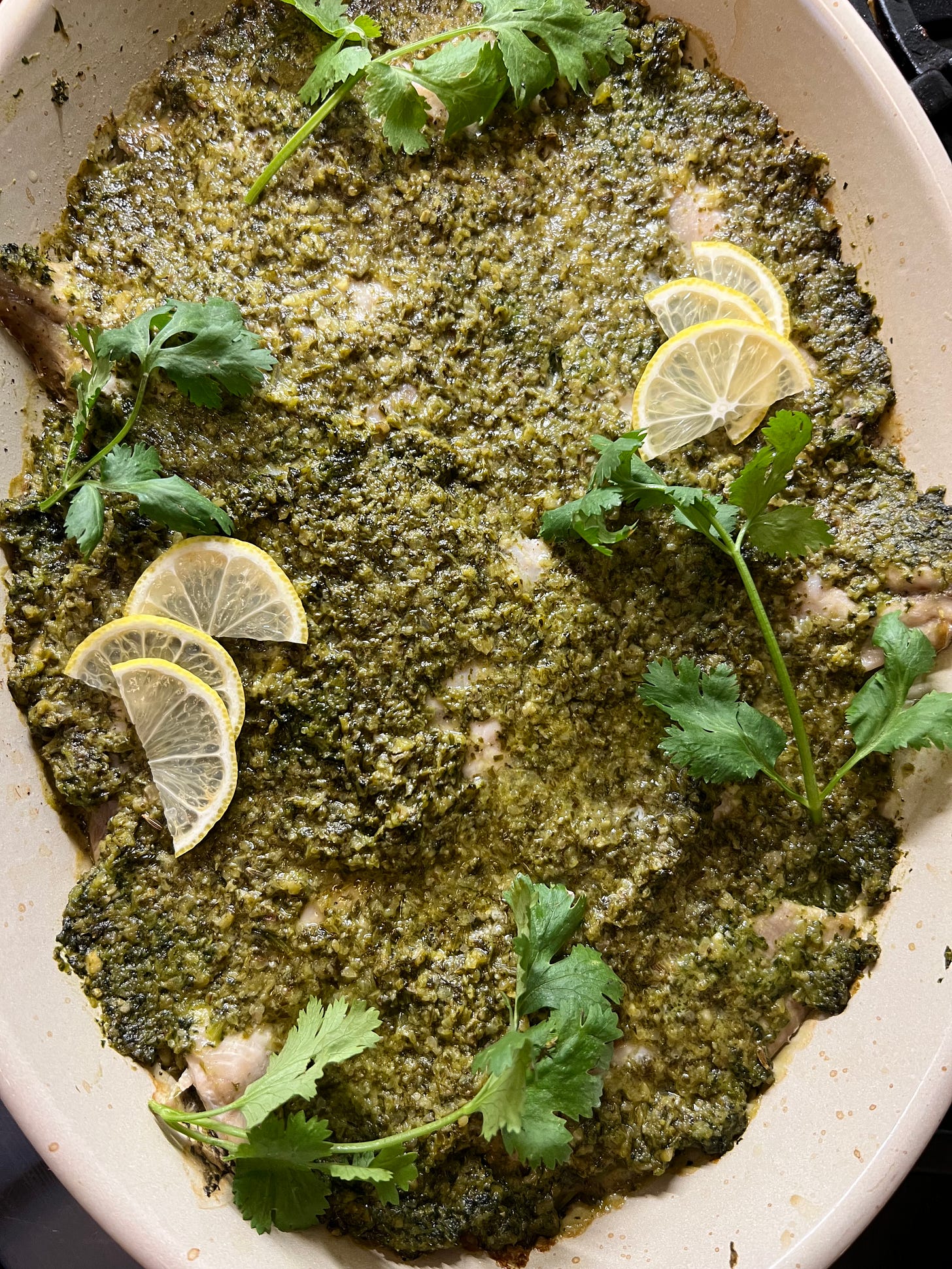
Always trying to come up with fish dishes that my husband Nate—who is not a fish lover and who usually prefers his fish disguised in some way—might like, the idea of samke harra came to mind. I had Dorita’s mother’s recipe in hand and did some flipping through my cookbooks and poking around on the Internet to see what else was out there. Because life is a circle, I stumbled on a recipe for samke harra on Food 52 contributed by Sara Jenkins. Sara is a friend, chef of the lovely Nina June in Rockport, Maine, which we visit yearly, and yes, she is the daughter of the same Nancy Jenkins with whom I first tasted samke harra so many years ago. I’ve made some version of samke harra ever since.
A couple of weeks ago at my sister’s cottage, I made Sara’s samke harra as part of an Indian meal I was cooking for my family. Though Lebanon’s northern port town of Tripoli, which is said to be the home of samke harra, is nowhere near Mumbai, I felt the flavor profile of the fish—coriander, cumin, walnuts, garlic, chili pepper—would work well with the other dishes I was preparing. It would also be a good use for the beautiful, fresh, local trout that my sister orders from a fish shop in Baysville, Ontario, the nearest town to her cottage. As always, the samke harra was a hit.
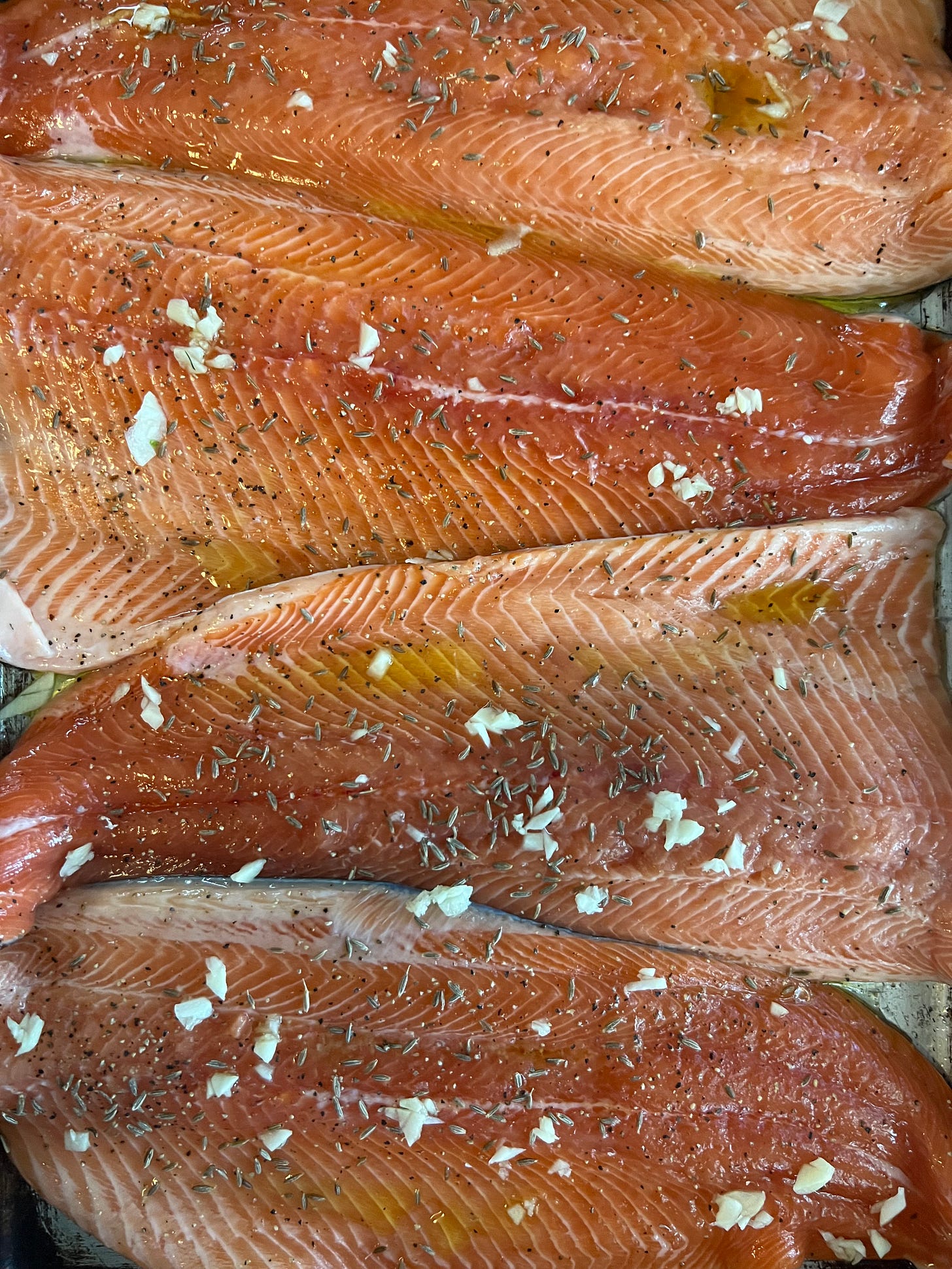
A Versatile Fish Dish
In addition to the beguiling flavors of samke harra, there are a few other things I love about the dish. For starters, it falls into that category of fish dishes that you can’t really overcook, within reason, because the sauce keeps it moist and succulent. This makes it a good fish entrée to prepare for a large group. It is delicious hot, warm, room temperature, and even cold. Samke harra is also suitable for any number of different types of fish. I’ve made it with striped bass, black bass, porgy (which is what Sara recommends), cod, halibut, and that beautiful trout at my sister’s cottage.
I suggest you give it a try.
RECIPE: Sara’s Spicy Fish
(Makes 6 servings)
1 ½ pounds fish fillets, such as porgy, black sea bass, striped sea bass, trout, halibut, or what have you, preferably with skin attached
1/2 teaspoon cumin seeds
Salt
Freshly ground black pepper
1 clove garlic, minced
6 tablespoons extra-virgin olive oil, divided, plus a little more to grease the pan
2 large bunches cilantro, cleaned
1/2 cup walnut halves, plus a little more for good measure, roughly chopped
½ large Spanish onion, chopped (about 1 overflowing cup)
1 fresh chili, such as jalapeño, serrano, or other (depending on your spice tolerance), seeded and roughly chopped
1 teaspoon ground cumin
1 teaspoon ground coriander
1/4 teaspoon ground cardamom
Juice of 2 lemons, about ½ cup, and a few thin slices for garnish
Preheat the oven to 450°F. With a little olive oil, grease a baking dish or sheet pan just large enough to hold the fillets in a single layer. Using tweezers, remove any pin bones and/or scales from the fish. Arrange the fish skin side down on the greased pan. Season with salt and pepper and sprinkle the cumin seed and minced garlic around to distribute evenly. Drizzle with 2 tablespoons of the olive oil and set aside.
Meanwhile, reserve a few sprigs of cilantro for garnish and roughly chop the rest, both leaves and tender stems. Transfer the cilantro to a food processor fitted with a metal chopping blade and add the walnuts, onion, chili, and a pinch of salt. Pulse to grind everything to a chunky paste. You don’t want it smooth.
In a large heavy saucepan, heat the remaining 4 tablespoons of olive oil. Add the chunky cilantro mixture to the hot oil in the pan and sauté for 8 to 10 minutes, until fragrant. Season with salt and add the cumin, coriander, and cardamom, and continue cooking over low heat for another 10 minutes or so to warm the spices and have the sauce come together. (You can make the sauce in advance until this point and set the pan aside. Before proceeding, reheat over a low flame and rehydrate with a little water or stock before continuing.)
Meanwhile, set the fish in the preheated oven for about 7 to 10 minutes, depending on the thickness of the fillets, until just barely cooked through. Remove from the oven and lower the temperature to 300°F. When the sauce is done, spoon it over the cooked fish fillets to cover evenly. Pour the lemon juice over the fish. Return to the reduced oven and let cook another 10 to 15 minutes or so, until the sauce is thoroughly heated and set. Garnish with the reserved cilantro sprigs and a few lemon slices. Serve hot, warm, or at room temperature.



